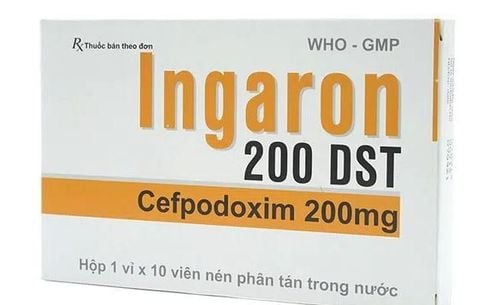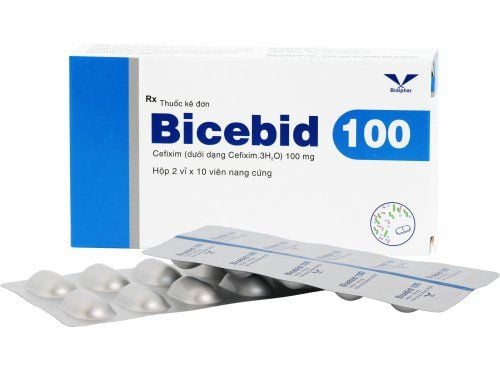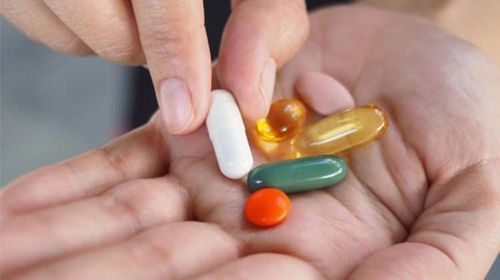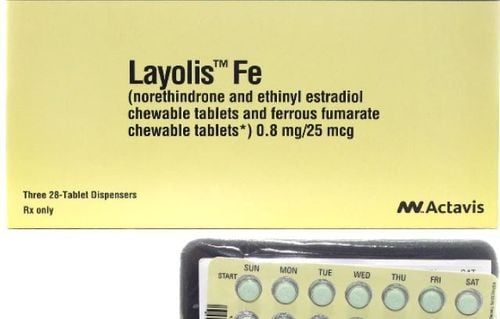This is an automatically translated article.
Ausfalex drug belongs to the group of parasitic, anti-infective, antifungal, antiviral drugs, used to treat infections of the respiratory tract and ENT, urinary and genital tract, skin and oral tissues. So what is Ausfalex and what is it used for?
1. What is Ausfalex?
Ausflex medicine has the active ingredient Cephalexin, which is prepared in the form of Cephalexin monohydrate 250mg and other excipients including white sugar, Aspartam, Microcrystalline cellulose, Cabosil M5, strawberry flavor powder, just enough for 1 tablet.
The drug is prepared in the form of powder mixed with oral solution, packed into boxes, each box contains 30 packs x 2.5g.
2. Uses of Ausfalex
2.1 Uses - indications Ausfalex is indicated for the treatment of infections caused by susceptible bacteria of mild and moderate severity. Specifically:
People with respiratory tract infections: Acute and chronic bronchitis, infectious bronchiectasis Persons with ear, nose, and throat infections: otitis media, sinusitis, tonsillitis, pharyngitis and inflammation mastoid bone. People with urinary tract infections: prostatitis and cystitis. May be used to prevent recurrent urinary tract infections. People with obstetric and gynecological infections. People with bone, skin and soft tissue infections. People with gonorrhea, when penicillin is not suitable. People with dental infections. The drug can be used as a prophylactic instead of penicillin for people with heart disease requiring dental treatment. 2.2 Contraindications Cases contraindicated to use Ausfalex:
Patients with a history of allergy or hypersensitivity to antibiotics of the Cephalosporin group. Patients with a history of penicillin-induced anaphylaxis or other severe IgE immune globulin-mediated reactions. Note: Contraindications should be understood as absolutely not using the drug, not for any reason that the cases are flexible to use the drug.
3. Usage and dosage of Ausfalex
How to use: Ausfalex is prepared in the form of a powder that should be used orally. Users should mix the drug with a sufficient amount of water, stir well before drinking. Should be used immediately after mixing.
Dosage:
Usual doses:
For adults and children over 12 years old: 500mg x 3 times/day. For children from 5-12 years old: 250mg x 3 times/day For children from 1-5 years old: 125mg x 3 times/day. For children under 1 year old: dose 125mg x 2 times/day. Other cases:
Adults with severe or deep localized infections: 1g x 3 times/day or 1.5g x 4 times/day. Prophylaxis of recurrent urinary tract infections: 125 mg per night is recommended and continued for several months. For people with gonorrhea: a single dose of 3g in combination with probenecide for men and 2g in combination with 0.5g of probenecide for women. For people with kidney disease: maximum dose of 6g/day for adults and 4g/day for children. For these patients, the dose should be adjusted accordingly. Note: For users who are children, the dosage should be calculated based on body weight. For the elderly, the possibility of kidney failure should be considered. Users need to apply the exact dose of Ausfalex as indicated on the package, the drug instruction sheet or as directed by the doctor or pharmacist. Absolutely do not arbitrarily calculate, use or change the dosage.
In case of missed dose: usually Ausfalex can be taken within 1 to 2 hours compared to the indicated in the prescription. Unless there is a strict rule about the time of taking the drug, users can use it after a few hours when it is discovered that a missed dose is detected. However, if the time of remembering is too close to the time for the next dose, skip the missed dose and take the dose at the prescribed time. Do not take a double dose to make up for the missed dose. dangerous to the body. Note: Users need to adhere to the correct dosage to get the best treatment results.
In case of overdose: when taking an overdose, the user usually only feels nausea, vomiting and diarrhea. However, there may be cases of neuromuscular hypersensitivity and seizures, especially in patients with renal failure.
Treatment: no need to wash the stomach, unless the user has taken Cephalexin 5 to 10 times the normal dose. Dialysis can be used to help remove the drug from the blood, but it is not necessary.
The patient needs respiratory protection, ventilation and fluid support measures. Give the patient several times activated charcoal to replace or support gastric lavage. During gastric lavage or using activated charcoal, the patient's respiratory tract also needs to be protected.
4. Undesirable side effects of Ausfalex
When using the drug Ausfalex, users may experience some unwanted side effects, the rate is about 3-6% of the entire treatment population. Specifically:
Common cases
Digestive system effects: causing nausea, diarrhea. Rare cases:
Blood effects: increased eosinophils Skin effects: pruritus, rash, urticaria Liver effects: reversible increase in liver transaminases. Rare cases:
Systemic effects: causing headache, dizziness, fatigue, anaphylactic reactions. Blood effects: thrombocytopenia, neutropenia. Effects on the digestive system: causing abdominal pain, digestive disorders, pseudomembranous colitis. Skin effects: erythema multiforme, Stevens-Johnson syndrome, toxic epidermal necrolysis, Quincke's edema Liver effects: hepatitis, cholestatic jaundice. Effects on the urogenital tract: causing genital itching, vaginitis, reversible interstitial nephritis. In addition, there have been reports of neurological symptoms such as dizziness, confusion, agitation and hallucinations, but no relationship with Cephalexin has been demonstrated.
How to handle:
When experiencing the above symptoms suspected of taking the drug, the user needs to stop taking the drug immediately. If symptoms are severe, supportive treatment should be instituted by: ensuring ventilation, administering epinephrine, oxygen, intravenous steroid injections. If you have mild pseudomembranous colitis, you usually just need to stop taking the medication. In moderate to severe cases, attention should be paid to fluid and electrolyte infusion, protein supplementation, and antibiotic therapy.
5. Ausfalex drug interactions
Taking high doses of Ausfalex with nephrotoxic drugs such as Aminoglycosides, strong diuretics, adversely affects kidney function.
Cephalexin may reduce the oestrogenic effect of oral contraceptives
Probenecid increases serum concentrations and increases the half-life of the active substance Cephalexin. This interaction is exploited in the treatment of gonorrhea.
6. Some notes when using Ausfalex drug
The active ingredient Cephalexin is usually well tolerated even when the patient is allergic to penicillin, although there have been rare cases of cross-allergic reactions.When used for a long time, may cause overgrowth of non-susceptible bacteria such as candida, enterococcus.... Users should use the drug in this case.
When there are kidney problems, it is necessary to reduce the dose to be appropriate.
For people who are pregnant: there are no studies showing signs of toxicity to the fetus, however, the drug should only be used when absolutely necessary as directed by a doctor.
For people who are breastfeeding: consider stopping the drug while breastfeeding, even though the concentration of cephalexin in breast milk is very low.
Hopefully, the information shared about the indications - contraindications, dosage and some notes of Ausfalex will help users understand and feel more secure when using.
Please dial HOTLINE for more information or register for an appointment HERE. Download MyVinmec app to make appointments faster and to manage your bookings easily.













